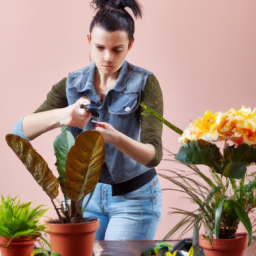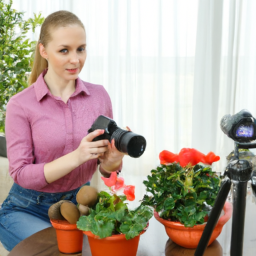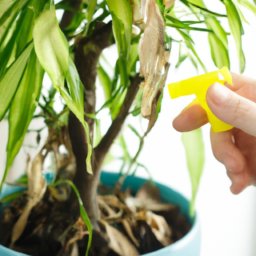
Are you a beginner gardener who is excited to dive into the world of plants and flowers, but finding yourself facing some unexpected challenges along the way? Don’t worry, you’re not alone! Troubleshooting common issues for beginner gardeners is a crucial part of the learning process. Whether it’s dealing with pests, understanding soil conditions, or figuring out the right amount of water to give your plants, we’ve all been there. In this blog post, we will explore some of the most common issues that beginner gardeners face and provide practical tips and solutions to help you overcome them. So, let’s get started and turn those gardening challenges into opportunities for growth and success!
Identifying and Treating Pest Infestations in Your Garden
Gardening can be a rewarding and enjoyable hobby, but it can also come with its fair share of challenges. One of the most common issues that beginner gardeners face is dealing with pest infestations. These unwanted visitors can wreak havoc on your plants and undo all of your hard work. In this guide, we will walk you through the process of identifying and treating pest infestations in your garden, so you can keep your plants healthy and thriving.
1. Recognizing the Signs of Pest Infestations
The first step in troubleshooting pest infestations is to identify the signs of their presence. By recognizing these signs early on, you can take action before the infestation gets out of control. Here are some common signs to look out for:
1.1. Wilting or Discolored Leaves: If you notice that your plants’ leaves are wilting, turning yellow, or developing brown spots, it could be a sign of pest infestation. Some pests feed on the leaves, causing damage and discoloration.
1.2. Holes or Chewed Leaves: Holes or chewed leaves are a clear indication that pests are feasting on your plants. Inspect the leaves carefully, as some pests may only leave small puncture marks.
1.3. Sticky Residue: If you notice a sticky residue on your plants’ leaves or the surrounding surfaces, it could be a sign of aphids or other sap-sucking insects. This residue is called honeydew and is excreted by these pests as they feed.
2. Common Garden Pests and How to Deal with Them
Now that you know how to recognize the signs of pest infestations, let’s take a closer look at some common garden pests and how to treat them:
2.1. Aphids: Aphids are small, soft-bodied insects that feed on the sap of plants. To control aphids, you can try spraying a mixture of water and dish soap on the affected plants. Alternatively, you can introduce natural predators like ladybugs or lacewings to your garden, as they feed on aphids.
2.2. Slugs and Snails: Slugs and snails can quickly devour your plants, especially during wet weather. To deter them, create barriers using materials like crushed eggshells or diatomaceous earth around your plants. You can also set up beer traps by burying containers filled with beer in the ground. The slugs and snails will be attracted to the beer and drown.
2.3. Caterpillars: Caterpillars can cause extensive damage to your plants by feeding on leaves and fruits. To control caterpillars, you can manually remove them from your plants and relocate them elsewhere. Another option is to use organic insecticides that specifically target caterpillars.
3. Preventing Future Pest Infestations
While it’s important to address current pest infestations, it’s equally crucial to take steps to prevent future outbreaks. Here are some preventive measures you can implement:
3.1. Maintain Good Garden Hygiene: Keep your garden clean and tidy by removing fallen leaves, weeds, and any decaying plant matter. This reduces the hiding places and food sources for pests.
3.2. Choose Resistant Plant Varieties: When selecting plants for your garden, opt for varieties that are known to be resistant to common pests in your area. This can significantly reduce the risk of infestations.
3.3. Attract Beneficial Insects: Encourage the presence of beneficial insects, such as ladybugs, lacewings, and praying mantises, in your garden. These insects prey on garden pests and help keep their populations in check.
Gardening is a journey of learning and experimentation, and dealing with pest infestations is just one part of it. By following the steps outlined in this guide, you can effectively troubleshoot and treat common pest issues in your garden. Remember to stay vigilant, observe your plants regularly, and take prompt action when necessary. With time and experience, you will become a confident gardener capable of maintaining a thriving and pest-free garden.

Dealing with Soil Issues: Understanding pH Levels and Nutrient Deficiencies
As a beginner gardener, one of the most common issues you may encounter is soil-related problems. Understanding pH levels and nutrient deficiencies is crucial for maintaining a healthy garden. In this guide, we will explore how to troubleshoot these issues step by step.
Understanding pH Levels
Soil pH is a measure of the acidity or alkalinity of the soil. It plays a vital role in determining the availability of nutrients to plants. Most plants prefer a slightly acidic to neutral pH range of 6.0 to 7.0. However, different plants have specific pH preferences, so it’s essential to know the requirements of the plants in your garden.
If you notice stunted growth, yellowing leaves, or poor overall plant health, it could indicate a pH imbalance. To determine the pH level of your soil, you can use a soil testing kit available at most garden centers or send a sample to a local agricultural extension service for analysis.
If the pH is too low (acidic), you can raise it by adding lime or wood ash to the soil. On the other hand, if the pH is too high (alkaline), you can lower it by incorporating elemental sulfur or acidic organic matter like pine needles or peat moss.
Remember that adjusting pH takes time, so be patient and monitor the changes over several weeks or months. Regular testing is also necessary to ensure the pH remains within the desired range.
Identifying Nutrient Deficiencies
Plants require various essential nutrients for healthy growth. Nutrient deficiencies can lead to stunted growth, yellowing or discolored leaves, and poor fruit or flower development. Here are some common nutrient deficiencies and their symptoms:
Nitrogen Deficiency: Plants lacking nitrogen often exhibit pale or yellowish leaves, especially in older leaves. They may also have stunted growth and produce fewer flowers or fruits.
Phosphorus Deficiency: Plants with phosphorus deficiency show slow growth and dark green or purple leaves. They may also have delayed flowering or fruiting.
Potassium Deficiency: Potassium-deficient plants have yellowing or browning leaf margins and weak stems. Flowers and fruits may also be smaller and less vibrant.
Calcium Deficiency: Calcium deficiency can cause distorted or necrotic (dead) leaf tips and edges. Fruits may develop blossom end rot, where the bottom part becomes sunken and dark.
Magnesium Deficiency: Plants lacking magnesium display yellowing between leaf veins, while the veins themselves remain green. This is known as interveinal chlorosis.
Iron Deficiency: Iron-deficient plants have yellow leaves with green veins. This condition is called chlorosis and often affects younger leaves first.
Zinc Deficiency: Zinc deficiency leads to stunted growth, distorted leaves, and delayed flowering or fruiting.
If you suspect a nutrient deficiency, it’s best to conduct a soil test to confirm the issue. Soil testing will help identify the specific nutrient deficiency and guide you in choosing the appropriate fertilizer or soil amendment.
Organic matter like compost or well-rotted manure is an excellent way to improve overall soil fertility and nutrient availability. It not only provides essential nutrients but also improves soil structure and water-holding capacity.
Remember to follow the recommended application rates when using fertilizers or soil amendments. Overapplication can lead to nutrient imbalances or even harm plants.
Conclusion
By understanding pH levels and nutrient deficiencies, you can troubleshoot common soil issues that beginner gardeners often face. Regular soil testing, proper pH adjustment, and providing the necessary nutrients will help you maintain a healthy and thriving garden. Remember to monitor your plants closely and make adjustments as needed. Happy gardening!

Common Mistakes to Avoid for Beginner Gardeners: Overwatering, Underwatering, and Improper Planting Techniques
Overwatering
Overwatering is one of the most common mistakes beginner gardeners make. It’s understandable to want to give your plants plenty of water, but too much can actually harm them. Here are a few signs that your plants may be suffering from overwatering:
1. Yellowing leaves: If you notice that the leaves of your plants are turning yellow, it could be a sign of overwatering. When plants receive too much water, their roots can become waterlogged, leading to a lack of oxygen and nutrient uptake. This can result in yellowing leaves.
2. Wilting: While it may seem counterintuitive, overwatered plants can actually wilt. This is because the roots are too saturated and cannot take up water properly. The excess water restricts the flow of nutrients and causes the plant to wilt.
3. Mold or fungus growth: Overwatering creates a damp environment that is conducive to the growth of mold and fungus. If you notice a fuzzy white or gray substance on the soil or leaves of your plants, it’s a sign of overwatering.
To avoid overwatering, it’s important to understand the specific water requirements of each plant. Some plants prefer moist soil, while others prefer to dry out between waterings. Here are some tips to help you avoid overwatering:
– Check the moisture level of the soil before watering. Stick your finger about an inch into the soil. If it feels dry, it’s time to water. If it feels moist, wait a little longer.
– Use well-draining soil. Soil that retains too much water can contribute to overwatering. Consider adding perlite or sand to improve drainage.
– Water deeply but infrequently. Instead of giving your plants frequent shallow waterings, water them deeply and allow the soil to dry out between waterings. This encourages the roots to grow deeper and become more resilient.
Underwatering
While overwatering is a common mistake, underwatering can be just as detrimental to your plants. Here are some signs that your plants may be underwatered:
1. Dry and brittle leaves: If the leaves of your plants are dry and brittle to the touch, it’s a sign that they are not receiving enough water. Underwatered plants lack the necessary moisture to maintain healthy foliage.
2. Stunted growth: When plants don’t receive enough water, their growth can become stunted. You may notice that your plants are not growing as quickly as they should or that their leaves are smaller than normal.
3. Drooping or wilting: Just like overwatered plants, underwatered plants can also wilt. However, the wilting in this case is due to a lack of water rather than excess water. The leaves may appear limp and droopy.
To avoid underwatering, it’s important to establish a consistent watering routine and pay attention to the specific water needs of each plant. Here are some tips:
– Check the moisture level of the soil regularly. Stick your finger into the soil and if it feels dry, it’s time to water. If it feels moist, wait a little longer.
– Water thoroughly. When you do water, make sure to thoroughly saturate the soil. This encourages the roots to grow deeper and ensures that the entire root system receives water.
– Mulch the soil. Mulching helps to retain moisture in the soil, reducing the frequency of watering. Apply a layer of organic mulch around your plants, leaving a small gap around the stem to prevent rot.
Improper Planting Techniques
Proper planting techniques are essential for the healthy growth of your plants. Here are some common mistakes to avoid:
1. Planting too deep: When planting seedlings or potted plants, it’s important to plant them at the correct depth. Planting too deep can lead to poor root development and hinder the plant’s ability to take up nutrients and water. Always follow the planting instructions for each specific plant.
2. Crowding plants: It can be tempting to pack as many plants as possible into a small space, but overcrowding can lead to competition for resources and poor air circulation. This can result in stunted growth and increased susceptibility to pests and diseases. Give your plants enough space to grow and thrive.
3. Neglecting soil preparation: Before planting, it’s important to prepare the soil properly. This includes removing weeds, breaking up compacted soil, and adding organic matter such as compost or well-rotted manure. Neglecting soil preparation can lead to poor drainage, nutrient deficiencies, and overall poor plant health.
When planting, follow these tips to ensure success:
– Dig a hole that is slightly wider and deeper than the root ball of the plant.
– Gently loosen the roots before placing the plant in the hole.
– Backfill the hole with soil, making sure to eliminate any air pockets.
– Water the newly planted seedling thoroughly to help settle the soil.
– Add a layer of mulch around the plant to help conserve moisture and suppress weeds.
By avoiding these common mistakes, beginner gardeners can set themselves up for success. Remember to observe your plants closely, adjust your watering practices accordingly, and provide them with the proper care they need. Happy gardening!
In a Nutshell
Are you a beginner gardener who is struggling with common issues? Don’t worry, you’re not alone! Many new gardeners face similar challenges when starting out. In this blog post, we will discuss some of the most common problems that beginners encounter and provide troubleshooting tips to help you overcome them.
One common issue that beginner gardeners face is overwatering their plants. It’s easy to get excited about taking care of your plants and end up drowning them with too much water. The key to avoiding this problem is to understand the watering needs of each plant. Some plants like to be watered more frequently, while others prefer drier conditions. By doing a little research and understanding the specific needs of your plants, you can prevent overwatering and ensure their healthy growth.
Another common issue for beginners is poor soil quality. If your plants are not thriving, it could be due to the lack of nutrients in the soil. To troubleshoot this problem, consider adding organic matter such as compost or manure to improve the soil’s fertility. Additionally, you can use fertilizers to provide essential nutrients that your plants may be lacking. By addressing soil quality issues, you can give your plants a better chance of flourishing.
Remember, gardening is a learning process, and it’s completely normal to encounter challenges along the way. By troubleshooting common issues and implementing the right solutions, you can become a successful gardener in no time. So don’t get discouraged and keep experimenting with different techniques until you find what works best for your plants. Happy gardening!
Check Out These FAQs:
Q1: Why are my plants wilting even though I water them regularly?
A1: Wilting plants can be caused by various factors. One common reason is overwatering, which leads to root rot and suffocates the plant. Ensure that you are not watering too frequently and that the soil has proper drainage. Another possibility is underwatering, where the plant is not receiving enough water to sustain itself. Check the soil moisture regularly and adjust your watering schedule accordingly.
Q2: How can I prevent pests from damaging my garden?
A2: Pests can be a nuisance for any gardener, but there are several preventive measures you can take. Start by keeping your garden clean and free of debris, as pests often hide in cluttered areas. Introduce beneficial insects like ladybugs or lacewings, as they feed on common garden pests. Additionally, you can use organic pest control methods such as neem oil or insecticidal soap to deter and eliminate pests without harming the environment.
Q3: Why are my plants turning yellow?
A3: Yellowing plants can indicate various issues. One common cause is nutrient deficiency, particularly lack of nitrogen, iron, or magnesium. Consider using a balanced fertilizer or specific nutrient supplements to address these deficiencies. Another possibility is improper watering, either over or underwatering. Ensure that you are watering your plants appropriately and adjust as needed. Lastly, yellowing can be a sign of disease or pest infestation, so inspect your plants closely for any signs of damage or infection.
Q4: How can I improve the soil quality in my garden?
A4: Improving soil quality is essential for healthy plant growth. Start by adding organic matter such as compost, leaf mold, or well-rotted manure to your soil. This helps improve drainage, retain moisture, and provide essential nutrients. Consider conducting a soil test to determine its pH level and nutrient content. Based on the results, you can adjust the soil’s pH with amendments like lime or sulfur and add specific fertilizers to address any deficiencies. Regularly aerating the soil by loosening it with a garden fork or tiller can also promote better root growth.
Q5: What should I do if my plants are not flowering?
A5: Lack of flowering can be due to various factors. First, consider the plant’s age as some species take longer to mature and produce flowers. Insufficient sunlight can also hinder flowering, so ensure your plants are receiving the recommended amount of direct or indirect sunlight. Another factor to consider is pruning. Some plants require pruning to stimulate flower production. Additionally, ensure that your plants are receiving adequate nutrients through proper fertilization. Finally, certain environmental conditions like extreme temperatures or excessive moisture can affect flowering, so try to provide optimal growing conditions for your plants.

Lisa Chen is a seasoned indoor gardening expert and the author of several bestselling books on the topic. With a background in horticulture and urban farming, Lisa is dedicated to helping urban dwellers embrace the joys of cultivating green spaces indoors. Her detailed guides and hands-on tips empower readers to transform their living spaces into thriving plant sanctuaries.


